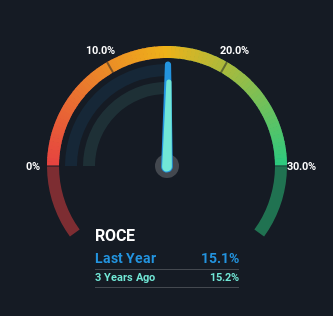- India
- /
- Specialty Stores
- /
- NSEI:EMIL
Returns On Capital At Electronics Mart India (NSE:EMIL) Paint A Concerning Picture

Did you know there are some financial metrics that can provide clues of a potential multi-bagger? Typically, we'll want to notice a trend of growing return on capital employed (ROCE) and alongside that, an expanding base of capital employed. This shows us that it's a compounding machine, able to continually reinvest its earnings back into the business and generate higher returns. In light of that, when we looked at Electronics Mart India (NSE:EMIL) and its ROCE trend, we weren't exactly thrilled.
What Is Return On Capital Employed (ROCE)?
Just to clarify if you're unsure, ROCE is a metric for evaluating how much pre-tax income (in percentage terms) a company earns on the capital invested in its business. To calculate this metric for Electronics Mart India, this is the formula:
Return on Capital Employed = Earnings Before Interest and Tax (EBIT) ÷ (Total Assets - Current Liabilities)
0.15 = ₹3.4b ÷ (₹31b - ₹7.8b) (Based on the trailing twelve months to March 2024).
Thus, Electronics Mart India has an ROCE of 15%. In absolute terms, that's a pretty normal return, and it's somewhat close to the Specialty Retail industry average of 17%.
See our latest analysis for Electronics Mart India

Above you can see how the current ROCE for Electronics Mart India compares to its prior returns on capital, but there's only so much you can tell from the past. If you're interested, you can view the analysts predictions in our free analyst report for Electronics Mart India .
The Trend Of ROCE
On the surface, the trend of ROCE at Electronics Mart India doesn't inspire confidence. Over the last five years, returns on capital have decreased to 15% from 25% five years ago. Although, given both revenue and the amount of assets employed in the business have increased, it could suggest the company is investing in growth, and the extra capital has led to a short-term reduction in ROCE. And if the increased capital generates additional returns, the business, and thus shareholders, will benefit in the long run.
On a side note, Electronics Mart India has done well to pay down its current liabilities to 26% of total assets. So we could link some of this to the decrease in ROCE. Effectively this means their suppliers or short-term creditors are funding less of the business, which reduces some elements of risk. Some would claim this reduces the business' efficiency at generating ROCE since it is now funding more of the operations with its own money.
The Bottom Line On Electronics Mart India's ROCE
Even though returns on capital have fallen in the short term, we find it promising that revenue and capital employed have both increased for Electronics Mart India. And long term investors must be optimistic going forward because the stock has returned a huge 154% to shareholders in the last year. So should these growth trends continue, we'd be optimistic on the stock going forward.
One more thing to note, we've identified 1 warning sign with Electronics Mart India and understanding it should be part of your investment process.
For those who like to invest in solid companies, check out this free list of companies with solid balance sheets and high returns on equity.
Valuation is complex, but we're here to simplify it.
Discover if Electronics Mart India might be undervalued or overvalued with our detailed analysis, featuring fair value estimates, potential risks, dividends, insider trades, and its financial condition.
Access Free AnalysisHave feedback on this article? Concerned about the content? Get in touch with us directly. Alternatively, email editorial-team (at) simplywallst.com.
This article by Simply Wall St is general in nature. We provide commentary based on historical data and analyst forecasts only using an unbiased methodology and our articles are not intended to be financial advice. It does not constitute a recommendation to buy or sell any stock, and does not take account of your objectives, or your financial situation. We aim to bring you long-term focused analysis driven by fundamental data. Note that our analysis may not factor in the latest price-sensitive company announcements or qualitative material. Simply Wall St has no position in any stocks mentioned.
Have feedback on this article? Concerned about the content? Get in touch with us directly. Alternatively, email editorial-team@simplywallst.com
About NSEI:EMIL
Electronics Mart India
Engages in the sale of consumer electronics and durable products in India.
Good value with moderate growth potential.
Similar Companies
Market Insights
Community Narratives



